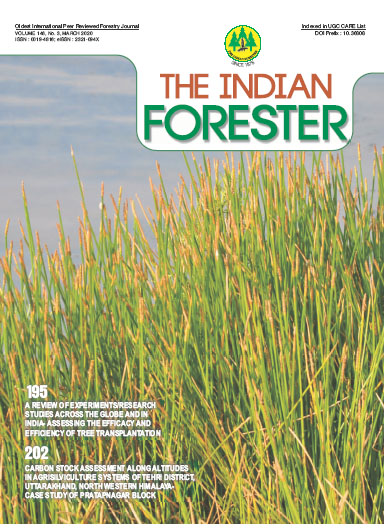Carbon Stock Assessment along Altitudes in Agrisilviculture Systems of Tehri District, Uttarakhand, North Western Himalaya - Case study of Pratapnagar block
DOI:
https://doi.org/10.36808/if/2020/v146i3/144384Keywords:
Climate Change, Agroforestry, Carbon Stock, Altitudes, Agrisilviculture System.Abstract
Agroforestry represents an integration of agriculture and forestry to increase productivity and sustainability offarming systems and farm income. Agroforestry is a viable alternative to prevent and mitigate climate change. This study therefore aimed to generate data on the carbon stocks ofagrisilviculture systems located in the Tehri district of Uttarakhand. The methodologies used include measurement of trees at diameter breast height (dbh) and sampling of branch, leaf, crops and soil for carbon content determination. Present results showed that carbon accumulation of agroforestry systems goes along with the following order; upper altitude (2000-2800 m) > middle altitude (1200-2000 m) > lower altitude (286-1200 m). Thus Agrisilviculture are not only remunerative to the farmers but also contributing towards tapping of atmospheric CO2 vis-a-vis mitigation of climate change. Policy programs promoting the establishment of agroforestry systems in ideal lands in Tehri district should be considered.References
Albrecht A. and Kandji S.T. (2003). Carbon sequestration in tropical agroforestry systems. Agriculture Ecosystem and Environment, 99:15-27.
Atul P. and Khosla PK. (1990). Agroforestry system for sustainable land use. Oxford and IBH publication, New Delhi, 221-227 pp.
Babu K, Dhinesh, Patel R.K., Deka B.C. and Bujabaruah KM. (2011). Maturity indices for harvesting of lower chilling peach cultivars under mid-hill condition of Meghalaya. Acta Horticulture, 890(40): 449-455.
Bhardwaj D.R., SannehA., Bhalendra, Singh Rajput and Kumar Sanjeev (2013). Status of Soil Organic Carbon Stocks Under Different Land Use Systems in Wet Temperate North Western Himalaya. Journal ofTree Sciences, 32 (1 and 2): 14-22.
Bitterlich W. (1984). The Relaskop idea. Farnham Royal: Commonwealth Agricultural Bureau.
Chidumayo E.N. (1990). Above-ground woody biomass structure and productivity in a Zambezian woodland. Forest Ecology and Management, 36: 33-46.
Dadhwal K.S., Narain P. and Dhyani S.K. (1989). Agroforestry systems in the Garhwal Himalayas of India. Agroforestry System, 7: 213-225.
Dixon R.K., Andrasko K.J., Sussman F.A., Lavinso M.A., Trexler M.C. and Wisniewski J. (1994). Carbon pools and flux of global forest ecosystems. Science, 263: 185-190.
Jana B.K., Biswas S., MajumderM., Roy P.K. and Mazumdar A. (2009). Carbon sequestration rate and above ground biomass carbon potential of four young species. Journal of Ecology and Natural Environment, 1:15-24.
Kanime N., Kaushal R., Tewari S.K., RaverkarK.P., Chaturvedi S. and Chaturvedi O.P. (2013). Biomass production and carbon sequestration in different tree-based systems of Central Himalayan, Tarai region. Forest Trees and Livelihoods, 22: 38-50.
Kumar Pawnesh. (1989). Evaluation of Biofuels of Solan district. Ph.D Thesis, Himanchal Pradesh, 82-83 pp.
Miles D. Parickand Smith W. Brad (2009). specific gravity and other properties of wood and bark for 156 tree species found in N. America, USDA, General Technical Report. 27-30 pp.
Montagnnin F. and Nair P.K.R. (2004). Carbon sequestration: an underexploited environment benefit of agroforestry systems: Agroforestry Systems, 61: 281-295
Nelson D.W. and Sommers L.E. (1996). Total carbon organic matter. In: D L Sparks etal. (Ed). Method of soil analysis, Madison, Wisconsin, Soil Science Societyof America, 961-1010.
Pressler M. (1865). Das Gestz derStammformbildung. Leipzig: Verlag Arnold.
Purkayastha S.K. (1982). Indian Woods: Theirldentification, Properties and Uses. The Controller of Publications, Delhi, India, 4: 172pp.
Rajput S.S., Shukla N.K. and Gupta V.K. (1985). Specific gravity of Indian timber. Journal of Timber Development Association of India, 31(3): 12-41
Raturi R.D., Chauhan L., Gupta S. and Vijendra R.R. (2002). Indian Woods: Their Identification, Properties and Uses. ICFRE Publication, Dehra Dun, India: Vol. 6
Rizvi R.H., Dhyani S.K., Yadav R.S. and Singh R. (2011). Biomass production and carbon stock of poplar agroforestry systems in Yamunanagarand Saharanpur districts of northwestern India. Current Science, 100: 736-742.
Sanchez A. Pedro. (2000). Linking climate change research with food security and poverty reduction in the tropics. Agriculture, Ecosystem and Environment, 82: 371-383.
Singh R.A. (1980). Soil physical analysis. Kalyani Publishers, New Delhi 61-62 pp.
Singh J.S. and Singh S.P. (1992). Forests of Himalaya: Structure, Functioning and Impact of Man. Gyanodaya Prakashan, Nainital, Uttarakhand, India. 294pp.
Smith D.M. (1954). Maximum moisture content method for determining specific gravity of small wood samples. Forest Products Laboratory, Madison.
Swamy S.L. and Puri S. (2005). Biomass production and carbon sequestration of Gmelina arborea in plantation and agroforestry system in India. Agroforestry System, 64:181-195.
Toky O.P., Kumar P. and Khosla P.K. (1989). Structure and function of traditional agroforestry systems in Western Himalaya. I. Biomass and productivity. Agroforestry Systems, 9(1): 47-70.
Walkley A.J. and Black I. (1934). Estimation of soil organic carbon by chromic acid titration method. Soil Science, 37: 29-38.
Wani B.A., Bodha R.H. and Khan A. (2014). Wood specific gravity variation among five important hardwood species of Kashmir Himalaya. Pakistan Journal of Biological Science, 17(3): 395-401.
Woomer P.L. (1999). Impact of cultivation of carbon fluxes in woody savannas of Southern Africa. Water Air and Soil Pollution, 70: 403-412.
Downloads
Downloads
Published
How to Cite
Issue
Section
License
Unless otherwise stated, copyright or similar rights in all materials presented on the site, including graphical images, are owned by Indian Forester.





